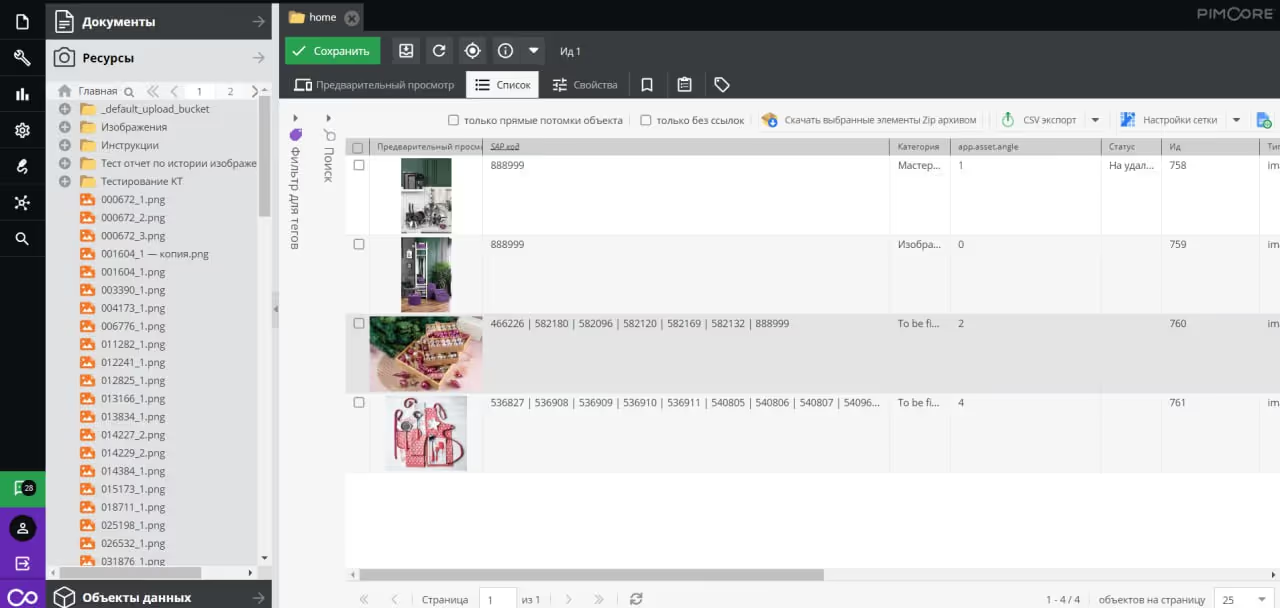The more digital content a company generates and uses, the more relevant it becomes for it to choose a DAM system, that is, a digital asset management system. DAM allows you to optimize business processes in branding and marketing, reduce the costs of producing, storing and updating digital assets for products and services. The DAM system automates the process of maintaining the consistency of visual, audio and video information on all sales, marketing channels, social networks and websites.
But there are nuances. Out of the box, the functionality of DAM systems varies from vendor to vendor. Plus, in addition to the general set of functions, each of the DAM systems has features that may or may not suit you depending on the source data.
In this article, the Pimcore team collected 10 main questions to ask yourself and the vendor when choosing a DAM system in order for the implementation to pay off. And KT.team supplemented them with cases from our clients' experience.
1. What business problems do you want to solve with DAM and will a specific system cover your needs?
The first step in implementing a DAM system is to determine which business tasks you want to solve by implementing. To do this, you will need to collect inputs from all departments that produce, modify, store and use digital assets related to goods and services. Where are the problems in their processes now? What is important to them in the future decision and what is not important? How much time are they currently spending looking for the right assets and why?
Thus, businesses whose main bottleneck is the long and unobvious search for files and metadata management costs will benefit from DAM systems with advanced metadata management capabilities, such as Pimcore.

Companies that face delays in approving and reviewing assets will benefit from using a DAM system with advanced collaboration and document management capabilities, such as Picvario.

One of KT.team's clients, a large retail chain, called among the main pains is the risk of disabling its existing DAM system. A foreign vendor could unilaterally stop working with Russian users at any time. For the retail chain, this would mean that 400,000 product cards from its catalog would be left without photos and videos both on the chain's own sales channels and on marketplaces. For this client, KT.team specialists selected DAM with open source and the ability to publish on the company's own servers.
2. What are the capabilities of a particular DAM system?
The second thing you should pay attention to is the set of functions of the DAM system out of the box. They will have to be correlated with your IT architecture and the needs of your teams.
We will not here touch on the basic functions for storing, validating, and filtering digital assets: only the nuances of their implementation depend on the vendor, but not the fact that they are available.
Therefore, the first thing you should pay close attention to is advanced featuresthat provide DAM systems. For example, AI-enabled image recognition, background removal, automatic tagging, automatic watermarking, tools for editing videos or working with 3D files...
And there's a caveat here. When choosing DAM, it is better to focus on the needs that you have at the moment or will arise in the next six months to a year.
Each additional feature usually makes the system more expensive on its own and requires additional infrastructure resources.
The second thing to talk about with an integrator or vendor is the ability to integrate DAM with existing systems: content management system (CMS), PIM (product data management system), marketing automation platforms, e-commerce systems, and supplier or distributor systems. Are there ready-made APIs, connectors, and integration modules, or will they have to be ordered separately?
The platform's open source code and the presence of a community come to the rescue here. The lower the popularity of the system, the fewer business users it has, and the less likely it is that ready-made modules or APIs have already been written and tested by someone.
3. Does the DAM system meet the needs of future key users?
The success of implementing a DAM system largely depends on how it will be accepted by users.
It is important to understand not just is it necessary system (once you think about it, you probably need it), but first of all — who will use it and what work tasks it should solve using DAM. This allows you to more accurately determine the vendor of the system.
For example, if the marketing team plans to use the DAM system first, you will need special features to manage brand assets and advertising and marketing campaign materials.
Creative teams are likely to need tools to collaborate on files.
The e-commerce division will request the function of transferring different sets of media content to different sales channels to take into account the requirements of the sites.
If the chosen DAM does not meet the needs of key users, its implementation will be much less useful than it could. Also consider whether the vendor or integrator provides comprehensive training and support so that users can use the system correctly.
4. Is DAM scalable and customizable?
DAM's scalable and customizable software can adapt to changing business needs, support growth and expansion, and improve operational efficiency and performance.
When assessing scalability, it is important to understand how the vendor will support upgrades, migrations, and maintenance over time.
As for customization options, you should evaluate:
- software flexibility with respect to the user interface;
- flexibility of metadata schemes;
- opportunities to automate work processes.
What should I look out for? For the frameworks and languages that the vendor uses when developing DAM, for ready-made APIs and integration options. This will help you understand how the system can be adapted to your business requirements.
5. What is the Total Cost of Ownership (TCO)?
Implementing the system is just the beginning. When calculating TCO, all costs associated with implementing and maintaining a DAM system should be taken into account. This is:
- initial implementation and configuration;
- license fees — initial and recurring, if the selected system is distributed only by subscription;
- training business users;
- the cost of extensions and add-ons that are necessary for your work and are not included in the “box”;
- availability on the market and cost of specialists who will support the system, etc.
Often, a system that seems more affordable during the integration phase has a higher cost of ownership in the long run. In a couple of years, the initial benefits will be more than offset by current payments and problems finding suitable contractors.
For example, improvements to Brandquad's DAM functionality are possible only through a vendor. On the one hand, this removes the issue of selecting a contractor. On the other hand, it increases the time and cost of each revision, as you will have to adapt to the vendor's overall backlog.
6. What is the entry threshold: how easy is it for users to learn DAM?
The DAM system can be perfectly designed, with many useful features and built-in options. But if users don't understand exactly how to use these features, if the interface is inconvenient and incomprehensible, and there is no reasonable training, then instead of optimizing processes, you'll end up with an Italian strike and a decrease in productivity.
Therefore, before implementing it, it makes sense to request a demo system from the vendor or its representative in order to independently evaluate the interfaces.
The best systems have an intuitive interface, sections and buttons are in obvious places, icons are easy to read, and automated processes (for example, image validation, metadata, watermarking) are obvious and predictable. To do this, the interface should be designed taking into account UX/UI standards that are familiar to the user.
Additional advantages will be:
- availability of open documentation and training courses from the vendor or its representative;
- the vendor or integrator's willingness to write instructions for your customized portal and provide training for users;
- willingness to accompany the learning process with advice and support.
7. How easy is it to integrate DAM with existing systems?
In this section, we (KT.team) will move away from translating the original article as much as possible.
In its text, Pimcore advises you to check whether there are ready-made solutions for integrating the chosen DAM with your existing CRM, CMS, ERP and other systems. And what is the experience of the solution provider in providing such integrations. Of course, this is one of the options to synchronize the entire IT circuit.
But direct integrations have their drawbacks: strong circuit connectivity, the need for constant improvements, and the constant complication of relationships between systems when new entities appear or existing ones change. Therefore, on our projects, we usually recommend integrating the DAM system with other company systems through the ESB layer. You can learn more about this method, for example, here→. The presence of a properly integrated bus in the IT circuit makes the circuit weakly connected: this allows you to make changes to each of the systems without the risk of blocking all business processes.
8. What deployment options (cloud or on-premises) does the vendor offer?
To get started, you'll need to answer a few questions within your company or project team:
- Are you planning to scale the system?
- What data security requirements does your company have?
- What are your company's regulatory requirements for IT systems?
By answering these questions, you'll determine whether cloud or on-premises are right for your company.
Cloud DAMs are supported by ease of deployment, flexibility, and scalability. This option allows you to organize remote interaction and speed up content delivery.
In turn, DAMs deployed on your servers provide greater control over the system and fewer vendor risks. As we have already mentioned, the on-prem location of the DAM system will protect the company from sudden disconnections from the vendor.
9. Does DAM offer a headless architecture?
The “headless” architecture is called a trend in building DAM systems. But the question is not whether the future system is in line with “fashion”.
The headless approach assumes that the back and front of the system are separate from each other. You can change the interface that users work with without affecting existing business processes. Or change the business processes on the back so that it does not (or minimally affects) the user interface.
Headless will be useful for organizations:
- who use multiple content delivery channels;
- who plan to integrate DAM with a large number of systems;
- whose activities involve multiple and complex processes of working with content.
For example, one of KT.Team's clients→ When working with content, many factors had to be taken into account: the relevance of the contract with modeling agencies, the relevance of the promotions and special offers mentioned on the layouts, geographical restrictions (photos with the “star” can only be used in some regions), and restrictions on marketing channels. The Headless DAM system was suitable for this customer.
But we should take into account that a headless DAM system requires higher technical expertise from both the contractor who will configure the system and the team that will continue to provide support.
10. What are the reporting and analytics capabilities?
Reporting and analytics modules are built into all DAM systems to help business users and customers make management decisions or refine product cards more reasonably.
But different systems have different reporting capabilities, as does the ease of generating reports.
As a rule, systems already have standard reports available, such as reports on the use and loading of media assets. Some DAMs allow you to customize custom reports that are tailored to your organization's requirements.
For example, for one of our clients, we have set up two types of reports in Pimcore:
- by images — allows you to find all files with a specific upload date and, for example, mark them as irrelevant. This is how the retailer removes seasonal product photos from all sales channels;
- by products and images — reports allow you to see how products and images are related and whether there are any products to which no images are linked. After receiving a list of such items, content managers can quickly fix the problem with blank cards.
Separately, it is worth clarifying whether DAM involves integration with BI systems and how data visualization can be configured.
How to get the most out of your DAM investment
The key to effective investment in DAM lies in the right questions at the stage of choosing a system. Here are a summary of questions to ask your team and the integrator team.
Questions for yourself and business users:
- What business pains and problems do we want to solve by implementing a DAM system?
- What metrics do we plan to influence?
- Which units will be the owners and main users of the DAM system? What are their tasks when working with media content?
- What DAM capabilities will you need over the next year and a half?
- What IT security restrictions do you have?
- How do you plan to grow and scale over the next few years?
Questions to the vendor and/or contractor:
- What features does the DAM system have out of the box?
- How will it be possible to improve features or develop new features?
- What features for customizing product cards and metadata schemes are included in DAM?
- Is the DAM system scalable?
- What deployment options are available?
- How is technical support organized?
- Is training for new users planned and how exactly can it be implemented?
- What reporting and analytics capabilities are built into DAM out of the box, and what can be further configured?
- What is the contractor's experience in implementing DAM systems?
You can read KT.team's cases on implementing DAM and PIM systems here→.
Do you have any questions? Sign up for a free consultation on the implementation of DAM↓.








